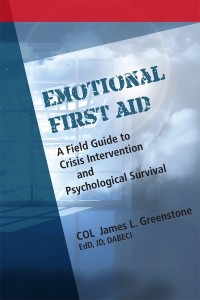Disaster Response: Don’t Just Show Up!
Taken from Emotional First Aid: A field guide to crisis intervention and psychological survival, by
Stand in the door. Lean forward. But don’t jump in if you are not called. A glance at the personal reports and newspaper accounts of what happens when a disaster or major crisis situation occurs should tell this story to almost anyone. If an emergency happens in the street in front of your house, that may be different. If the disaster happens some distance away, wait to be called before responding. Get ready to go, but don’t do it. Let those in charge know that you are available, but don’t just show up. The problems get worse from there. A disaster is an occurrence of almost any size when the needs of the situation and its victims are greater than the resources available to respond to those needs. Unexpected, unrequested, and unaccounted for responders may add to the enormity of the already occurring disaster.
If you are serious about emergency and disaster response, join a team that does these things and trains its members to do it well. Federal teams are always looking for qualified professionals in many different fields. State and local teams are preparing also and could probably use the help. Some pay and some do not. Medical Reserve Corps have become quite active across this nation as are the American Red Cross and Salvation Army.
As was said earlier, the rule of thumb for most teams and organizations that respond to crisis and disaster situations is that if you are not called, don’t just show up. Do the training. Assemble your response gear. Be ready, willing, able and well-prepared to go when called. Let your team know of your availability and how quickly you can be on the move to the designated location or staging area. Don’t just show up.
The reasons for this cautionary tone will seem obvious to most, but not all reading it. Almost everyone wants to help when they hear that an emergency has occurred. This desire to help is good on the one hand and can be counterproductive on the other hand. Getting on a plane or in a car with your friends and colleagues and “going to help for a few days” may cause great confusion at the site or staging area and prevent trained and coordinated teams from reaching their destination in a timely fashion. Clogging the airways or the highways serves no one and could endanger those who are waiting for the help to arrive. Do-gooders have no place at a disaster scene. Trained and coordinated emergency personnel do. If you must go regardless of the consequences, at least coordinate with those who are in charge of the response and be sure that they can use your services. Take with you, in addition to your professional supplies, enough food, water, shelter, waste disposal gear, sleeping gear, and other survival supplies so that your arrival will not put added burden on those who already have limited means. Expect nothing from your host if you arrive when you are not called, requested, or needed. Assume that they have nothing to spare and that you will probably be operating on your own. If the conditions are not as stark as you expect, so much the better for you.
Disaster, emergency, and crisis response, regardless of the situation, needs to be carefully coordinated and regulated to achieve the best and most helpful results. The size of the event is not as important as the coordination of those services and service providers that are needed. The emergency, and the often occurring chaos surrounding it, make this approach mandatory. Even the best laid plans survive only the initial contact with the emergency. Adjustments have to be made and resources utilized appropriately and sometimes differently. What is done, undone or redone must be within the context of the established and prepared structure utilized by those who have trained and prepared to respond.
If you are not called, don’t just go. If you are prepared to go and are called, get there in the time allotted. If you are a member of a team, follow your team guidelines. If you are not a member of a team and would like to be, check out the following and investigate others:
1. Federal Disaster Medical Assistance Teams, United States Department of Health and Human Services.
2. American Red Cross
3. Salvation Army
4. Baptist Men’s Association
7. Federal Emergency Management Agency, Department of Homeland Security
8. National Guard
9. State Defense Forces
10. Green Cross
11. Urban Search and Rescue Teams
12. United States Air Force Auxiliary, Civil Air Patrol
13. Local community teams
14. Police department auxiliaries and reserves.
15. Fire department auxiliaries
16. Community Emergency Response Teams (CERT)
17. Mental Health Teams
18. Incident Command System, Incident Management Teams
19. Special Needs Shelters
20. Medical Shelters
21. Chaplain Services (if trained for disaster response)
22. Disaster relief within many denominations
Getting involved in a formal way requires a commitment of some kind. Doing so will allow for a better response. It will also allow for a more satisfying experience for you. Certainly it will prevent many of the problems that occur when well-wishers and do-gooders show up. To really be helpful, you need to be part of the solution rather than part of the already burgeoning problem. Don’t just show up.
Dr. Greenstone’s book Emotional First Aid from which the article above was taken, is a great place to start training yourself to be of optimal use in the field following a disaster. Although it is often difficult for us to leave the relatively safe environs of our offices, we recognize the need for psychological first aid. Utilize one of the organizations above to get trained, offer your services, and when accepted, GO.

